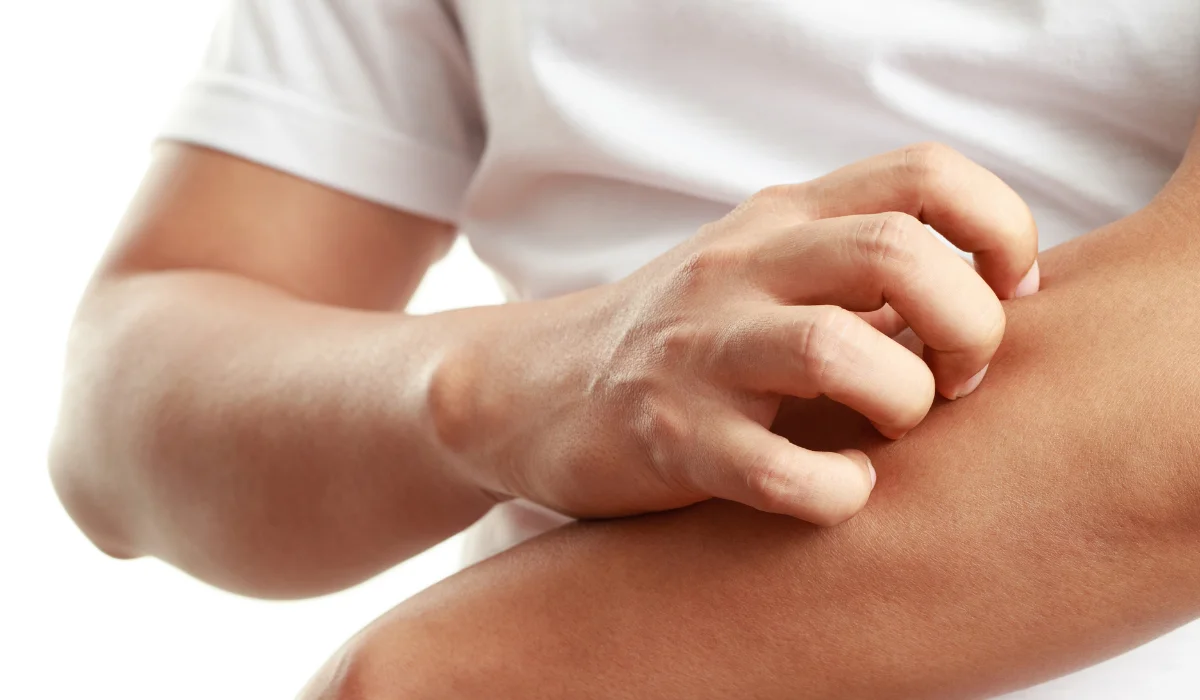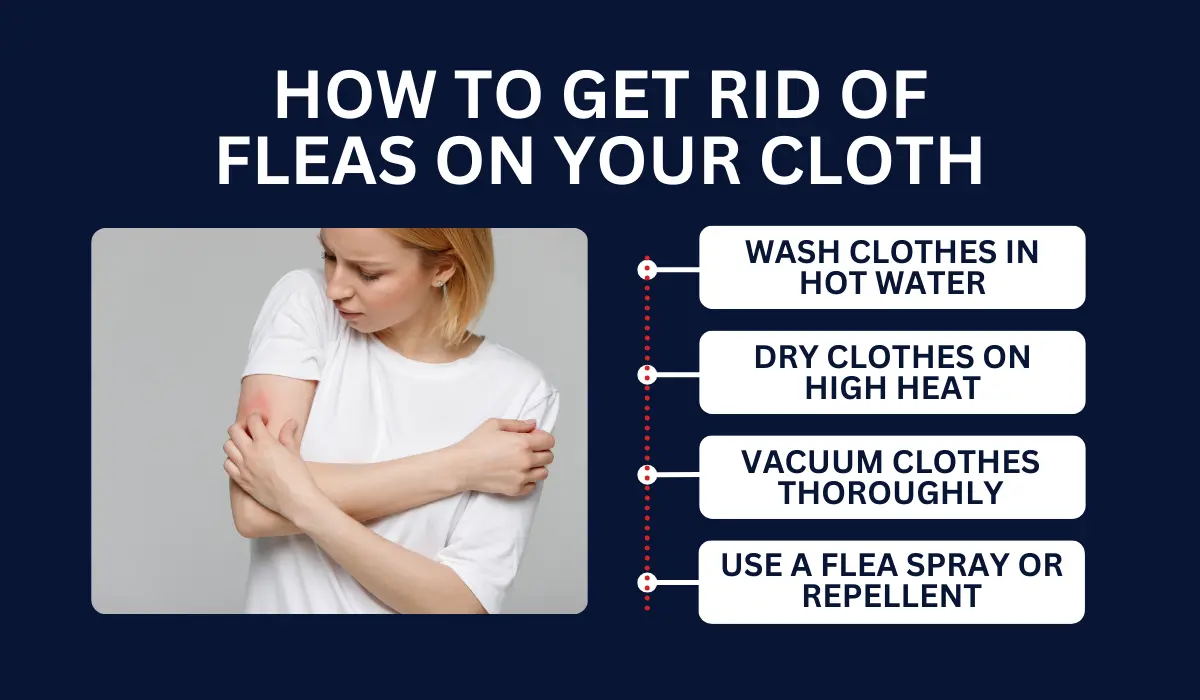
Fleas on clothes can be a nightmare, especially after visiting a friend’s house with infested pets. The easiest way to get rid of fleas on clothes is to wash them in hot water and dry them on high heat.
Want to learn the best methods to keep fleas at bay and how to prevent them from coming back? Keep reading to protect yourself and your clothes effectively.
Key Takeaways
- Washing clothes in hot water and drying them on high heat kills fleas at all life stages.
- Freezing infested clothes for at least 48 hours can eliminate fleas and prevent their life cycle from continuing.
- Regular vacuuming, especially with a HEPA filter, removes fleas from clothes that can’t be washed or dried at high temperatures.
- Consistent pet flea treatments and hiring pest control in your home are essential to prevent future flea infestations.
HOW TO GET RID OF FLEAS ON YOUR CLOTHES

Keeping your clothes free from flea problems involves several practical steps. Following these tips can protect your clothing and ensure a flea-free wardrobe.
1. Wash Clothes in Hot Water
Washing clothes in hot, soapy water is one of the most effective ways to get rid of fleas at all life stages. Fleas, including adult fleas, eggs, larvae, and pupae, cannot survive high temperatures.
To effectively remove fleas from clothing and bedding, set your washing machine to the highest water temperature possible, ideally above 140°F (60°C).
Add your regular laundry detergent. Make sure to launder all infested items thoroughly to disrupt and break the flea life cycle.
2. Dry Clothes on High Heat
High heat from a dryer can be just as effective as hot water. Fleas and their eggs cannot withstand the temperatures inside a dryer set to high heat.
After washing, set your dryer to the highest heat setting to kill any remaining fleas and eggs. Before doing so, always check the care instructions on your clothes to ensure they can safely withstand high temperatures without sustaining damage.
3. Vacuum Clothes Thoroughly
Vacuuming effectively removes fleas from clothes, especially for items that cannot be washed or dried at high temperatures. The suction helps to remove adult fleas, larvae, and flea dirt.
For effective flea removal from clothing, select a vacuum cleaner equipped with strong suction and a HEPA filter. Carefully vacuum all clothing surfaces and upholstery, paying special attention to seams and folds where they are likely to hide.
After vacuuming, dispose of the vacuum bag by sealing it in a plastic bag to prevent these pests from re-infesting your home.
4. Use a Flea Spray or Repellent
Treating your clothes with a flea spray or repellent can also prevent fleas. These products often contain active ingredients like permethrin or natural substances like diatomaceous earth.
To effectively protect your clothing from fleas, select a flea spray suitable for fabrics and deemed safe for use on clothes. Lightly spray the solution over your clothing, following the manufacturer’s instructions for proper application.
HOW TO PREVENT FUTURE WARDROBE INFESTATIONS
Recognize Common Signs of Fleas on Fabric
Identifying signs of flea activities early can help prevent a full-blown infestation. Here’s what you need to watch out for in clothing:
- Small red flea bites on your skin that can look like bed bug bites.
- Dark specks on clothing, which is flea dirt or dried blood.
- Seeing tiny jumping critters, which are adult fleas.
- Tiny white specks, which could be flea eggs.
- Flea larvae or cocoon-like structures in the seams and crevices of clothing.
Seal Gaps and Cracks
Ensuring your wardrobe and closets are well-sealed is crucial to keeping female fleas out. Mites and other pests can also enter the same smallest openings.
You reduce the risk of future infestations by inspecting all corners of the wardrobe, the edges of closets, and the baseboards for any gaps.
Then, seal any visible cracks using high-quality caulk or sealant to create a barrier against females that may lay eggs.
Maintain a Pet Treatment Schedule
Consistent flea treatment for pets is critical as they are often the primary carriers of fleas into the home. Spot-on treatments, flea collars, and flea medications like Frontline are effective.
Other components of a rigorous pet treatment schedule include:
| Pet Treatment | Description |
|---|---|
| Topical Preventatives | Applied directly to the pet’s skin for long-lasting protection. |
| Oral Medications | Administered by mouth for systemic protection. |
| Flea Collars | Products that release chemicals to repel and kill fleas. |
| Flea Comb | A fine-toothed comb to remove adult fleas from the pet’s fur. |
| Flea Powders | Applied to the pet’s fur to kill fleas on contact. |
| Flea shampoos | Kill fleas and remove eggs and larvae from the pet’s fur during baths. |
| Pet Bedding Cleaning | Washing with dish soap and hot water to prevent re-infestation. |
WHEN TO CALL A PROFESSIONAL
Fleas can be persistent and tricky to get rid of. If efforts to remove them from clothes aren’t working even after the first time, don’t wait until the problem escalates. It might be time to call in pest control professionals.
Whether you’re in Baton Rouge or New Orleans, seeking expert help should be easy. For immediate intervention for a severe infestation, let Lajaunie’s flea control specialists tailor a solution that’s right for your home.
For more information about our services, please visit our service page.